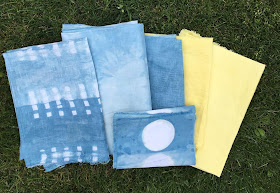Over the weekend, the temperatures were forecast to dip into the mid thirties, which lit a fire under my butt to get the indigo harvested.
A few of the plants had started to bloom.Batman helped me cut all the stems and strip the leaves. When I weighed them I discovered that we had FIVE pounds of leaves!
On Saturday afternoon I brewed a one pound jar of leaves and these are the results (above). The yellow is a result of the tansy "tea" I brewed on Saturday as well. Look here to see that fun.
On Monday, I brewed a second pound of indigo and these are the results (above, drying...and below, pressed). The remaining three pounds of indigo leaves are on a screen in the woodshed, drying for later use. But I've got to do more research to figure out how that may work!
I did some fabric manipulation or shibori with clothespins, clamped mason jar lids, stitched resist and fabric bunching.
To see my indigo dye day from 2016, look here.
My 2017 indigo harvest was successful, but my dye day was a tear producing flop.
That's why I have started a dye journal, as recommended by so many natural dyers. It's a place to keep track of all aspects of the gentle work of dyeing. It's a bit like alchemy...we can set things up for success, but it helps to be open to Mother Nature's whims.
These are the notes I posted on Instagram, explaining the methods I used...
I am using cotton, linen and some of my grandmother’s vintage tablecloths and hankies. I have scoured with soda ash, mordanted with aluminum acetate and done a wheat bran bath before I dye, following instructions in Kristine Vejar’s book The Modern Natural Dyer. (Mordant is not required for indigo, but now I have a generous supply of prepared fabric for other dyes I may try this fall). We harvested 5 pounds of indigo leaves from the garden. I used one pound on Saturday, I have another pound cooking on the stove now and three pounds are drying on a screen in the woodshed. I am following instructions for a (fresh) Japanese Indigo Vat found in Chris McLaughlin’s sweet book, A Garden to Dye For. The tansy was a simple “tea”, one pound of blossoms simmered in water for about 20 minutes.
Growing, dyeing and sewing with color from our gardens here at our bit of earth remains one of my deepest pleasures.
xo
My 2017 indigo harvest was successful, but my dye day was a tear producing flop.
That's why I have started a dye journal, as recommended by so many natural dyers. It's a place to keep track of all aspects of the gentle work of dyeing. It's a bit like alchemy...we can set things up for success, but it helps to be open to Mother Nature's whims.
These are the notes I posted on Instagram, explaining the methods I used...
I am using cotton, linen and some of my grandmother’s vintage tablecloths and hankies. I have scoured with soda ash, mordanted with aluminum acetate and done a wheat bran bath before I dye, following instructions in Kristine Vejar’s book The Modern Natural Dyer. (Mordant is not required for indigo, but now I have a generous supply of prepared fabric for other dyes I may try this fall). We harvested 5 pounds of indigo leaves from the garden. I used one pound on Saturday, I have another pound cooking on the stove now and three pounds are drying on a screen in the woodshed. I am following instructions for a (fresh) Japanese Indigo Vat found in Chris McLaughlin’s sweet book, A Garden to Dye For. The tansy was a simple “tea”, one pound of blossoms simmered in water for about 20 minutes.
Growing, dyeing and sewing with color from our gardens here at our bit of earth remains one of my deepest pleasures.
xo







I would imagine this to be so satisfying Karen (when it goes to plan!) I've only tried tea dyeing fabric so far. :)
ReplyDeletethe tansy was so very easy! Do you have any flowers in your garden that might work?
DeleteThis is so wonderful, Karen. I can tell this is something you're passionate about and your results are lovely. Enjoy the process! xo
ReplyDeleteThanks Judy! I love that the dyes are so local and natural. :-)
DeleteReally beautiful dyes, and so satisfying that you produced them yourself from your own plants!
ReplyDeleteThank you Paula!
DeleteOh wow! That is really beautiful Karen. You are so creative!
ReplyDeleteIt's such a fun process!
Deletei love dyeing with indigo; keeping a vat alive requires intuitive and practical skills. much luck to you on your journey!
ReplyDeleteGosh, I haven't tried a vat yet...I think that requires fermentation, something I have not yet tried.
DeleteMy infusion simmers on the stovetop and is only good for an afternoon of dyeing, then it exhausts itself. Where would you recommend I read about a vat?
oh, let's see...i would recommend any book or article by Yoshiko Iwamoto Wada; she's definitely an expert in shibori and indigo dyeing (or vat dyeing, as you can do other dyes that way as well). Wada is featured in Oct/Nov 2018 American Craft magazine.
Deletei went to school and learned how to dye, among other things. best decision i ever made.
Thank you for the tips!
Delete